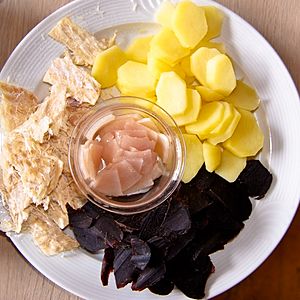Tvøst og spik facts for kids
Tvøst og spik (also known as Grind og spik) is a traditional dish from the Faroe Islands. These islands are a self-governing country that belongs to Denmark, located far out in the North Atlantic Ocean. The dish is made from pilot whale meat, blubber (whale fat), and potatoes.
Contents
What is Tvøst og Spik?
Tvøst is the name for the whale meat, and spik is the name for the blubber. This dish is a very important part of Faroese food culture. The meat is usually very dark, almost black.
How is the Meat Prepared?
The whale meat can be cooked in several ways. It can be:
- Boiled or fried when fresh.
- Stored in dry salt (called turrsaltað).
- Stored in very salty water (called lakasaltað).
- Frozen for later use.
- Hung outdoors to dry.
When drying, the meat is cut into long slices called grindalikkja. These slices are hung under a roof to protect them from rain.
How is the Blubber Prepared?
The blubber can also be prepared in different ways. It can be:
- Boiled.
- Salted.
- Dried.
Unlike the meat, blubber is not usually fried. Dried blubber is often eaten with dried fish, as you can see in the picture.
A Look at History
The tradition of eating whale meat and blubber goes back many centuries in the Faroe Islands. It was first mentioned in a law from 1298, called the Norwegian Gulating-law, which included rules for the Faroes.
Why is it Traditional?
The Faroe Islands are very isolated in the North Atlantic. For a long time, it was hard to get food supplies from other countries. This meant the islanders had to use whatever food nature provided around them.
Faroese cooking traditions developed to use a lot of local animal products. This included animals from farms like sheep, cows, geese, chickens, and ducks. They also relied on food from the sea, such as all kinds of fish, sea birds, and, from time to time, whale meat and blubber.


